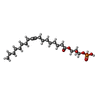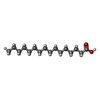+ Open data
Open data
- Basic information
Basic information
| Entry | Database: PDB / ID: 9ite | ||||||
|---|---|---|---|---|---|---|---|
| Title | LPA-bound LPAR6 in complex with miniG13 | ||||||
 Components Components |
| ||||||
 Keywords Keywords | MEMBRANE PROTEIN / GPCR-G-protein complex | ||||||
| Function / homology |  Function and homology information Function and homology informationlysophosphatidic acid receptor activity / P2Y receptors / blastocyst hatching / Olfactory Signaling Pathway / Activation of the phototransduction cascade / G beta:gamma signalling through PLC beta / Presynaptic function of Kainate receptors / Thromboxane signalling through TP receptor / G protein-coupled acetylcholine receptor signaling pathway / Activation of G protein gated Potassium channels ...lysophosphatidic acid receptor activity / P2Y receptors / blastocyst hatching / Olfactory Signaling Pathway / Activation of the phototransduction cascade / G beta:gamma signalling through PLC beta / Presynaptic function of Kainate receptors / Thromboxane signalling through TP receptor / G protein-coupled acetylcholine receptor signaling pathway / Activation of G protein gated Potassium channels / Inhibition of voltage gated Ca2+ channels via Gbeta/gamma subunits / G-protein activation / Prostacyclin signalling through prostacyclin receptor / G beta:gamma signalling through CDC42 / Glucagon signaling in metabolic regulation / G beta:gamma signalling through BTK / Synthesis, secretion, and inactivation of Glucagon-like Peptide-1 (GLP-1) / ADP signalling through P2Y purinoceptor 12 / photoreceptor disc membrane / Sensory perception of sweet, bitter, and umami (glutamate) taste / Glucagon-type ligand receptors / Adrenaline,noradrenaline inhibits insulin secretion / Vasopressin regulates renal water homeostasis via Aquaporins / Glucagon-like Peptide-1 (GLP1) regulates insulin secretion / G alpha (z) signalling events / cellular response to catecholamine stimulus / ADORA2B mediated anti-inflammatory cytokines production / ADP signalling through P2Y purinoceptor 1 / G beta:gamma signalling through PI3Kgamma / adenylate cyclase-activating dopamine receptor signaling pathway / Cooperation of PDCL (PhLP1) and TRiC/CCT in G-protein beta folding / GPER1 signaling / Inactivation, recovery and regulation of the phototransduction cascade / cellular response to prostaglandin E stimulus / G-protein beta-subunit binding / heterotrimeric G-protein complex / G alpha (12/13) signalling events / sensory perception of taste / extracellular vesicle / signaling receptor complex adaptor activity / Thrombin signalling through proteinase activated receptors (PARs) / retina development in camera-type eye / GTPase binding / Ca2+ pathway / fibroblast proliferation / High laminar flow shear stress activates signaling by PIEZO1 and PECAM1:CDH5:KDR in endothelial cells / G alpha (i) signalling events / G alpha (s) signalling events / phospholipase C-activating G protein-coupled receptor signaling pathway / G alpha (q) signalling events / Ras protein signal transduction / Extra-nuclear estrogen signaling / cell population proliferation / G protein-coupled receptor signaling pathway / lysosomal membrane / intracellular membrane-bounded organelle / GTPase activity / synapse / protein-containing complex binding / signal transduction / extracellular exosome / membrane / plasma membrane / cytoplasm / cytosol Similarity search - Function | ||||||
| Biological species |  Homo sapiens (human) Homo sapiens (human) | ||||||
| Method | ELECTRON MICROSCOPY / single particle reconstruction / cryo EM / Resolution: 3.06 Å | ||||||
 Authors Authors | He, Y. / Duan, Y. | ||||||
| Funding support |  China, 1items China, 1items
| ||||||
 Citation Citation |  Journal: Proc Natl Acad Sci U S A / Year: 2025 Journal: Proc Natl Acad Sci U S A / Year: 2025Title: Molecular mechanism of ligand recognition and activation of lysophosphatidic acid receptor LPAR6. Authors: Yaning Duan / Zhenmei Xu / Boyu Hao / Anqi Zhang / Changyou Guo / Yuanzheng He /  Abstract: Lysophosphatidic acid (LPA) exerts its physiological roles through the endothelialdifferentiation gene (EDG) family LPA receptors (LPAR1-3) or the non-EDG family LPA receptors (LPAR4-6). LPAR6 plays ...Lysophosphatidic acid (LPA) exerts its physiological roles through the endothelialdifferentiation gene (EDG) family LPA receptors (LPAR1-3) or the non-EDG family LPA receptors (LPAR4-6). LPAR6 plays crucial roles in hair loss and cancer progression, yet its structural information is very limited. Here, we report the cryoelectron microscopy structure of LPA-bound human LPAR6 in complex with a mini G or G protein. These structures reveal a distinct ligand binding and recognition mode that differs significantly from that of LPAR1. Specifically, LPA uses its charged head to form an extensive polar interaction network with key polar residues on the extracellular side of transmembrane helix 5-6 and the extracellular loop 2. Structural comparisons and homology analysis suggest that the EDG and non-EDG families use two distinct modes for LPA binding. The structural observations are validated through functional mutagenesis studies. We further uncover the mechanisms of LPAR6 activation and principles of G-protein coupling. The structural information revealed by our study lays the groundwork for understanding LPAR6 signaling and provides a rational basis for designing compounds targeting LPAR6. | ||||||
| History |
|
- Structure visualization
Structure visualization
| Structure viewer | Molecule:  Molmil Molmil Jmol/JSmol Jmol/JSmol |
|---|
- Downloads & links
Downloads & links
- Download
Download
| PDBx/mmCIF format |  9ite.cif.gz 9ite.cif.gz | 212.5 KB | Display |  PDBx/mmCIF format PDBx/mmCIF format |
|---|---|---|---|---|
| PDB format |  pdb9ite.ent.gz pdb9ite.ent.gz | 164.3 KB | Display |  PDB format PDB format |
| PDBx/mmJSON format |  9ite.json.gz 9ite.json.gz | Tree view |  PDBx/mmJSON format PDBx/mmJSON format | |
| Others |  Other downloads Other downloads |
-Validation report
| Summary document |  9ite_validation.pdf.gz 9ite_validation.pdf.gz | 585.1 KB | Display |  wwPDB validaton report wwPDB validaton report |
|---|---|---|---|---|
| Full document |  9ite_full_validation.pdf.gz 9ite_full_validation.pdf.gz | 609.2 KB | Display | |
| Data in XML |  9ite_validation.xml.gz 9ite_validation.xml.gz | 22.7 KB | Display | |
| Data in CIF |  9ite_validation.cif.gz 9ite_validation.cif.gz | 34.9 KB | Display | |
| Arichive directory |  https://data.pdbj.org/pub/pdb/validation_reports/it/9ite https://data.pdbj.org/pub/pdb/validation_reports/it/9ite ftp://data.pdbj.org/pub/pdb/validation_reports/it/9ite ftp://data.pdbj.org/pub/pdb/validation_reports/it/9ite | HTTPS FTP |
-Related structure data
| Related structure data |  60859MC  9itbC M: map data used to model this data C: citing same article ( |
|---|---|
| Similar structure data | Similarity search - Function & homology  F&H Search F&H Search |
- Links
Links
- Assembly
Assembly
| Deposited unit | 
|
|---|---|
| 1 |
|
- Components
Components
-Protein , 2 types, 2 molecules AR
| #1: Protein | Mass: 26574.400 Da / Num. of mol.: 1 Source method: isolated from a genetically manipulated source Source: (gene. exp.)  Homo sapiens (human) / Production host: Homo sapiens (human) / Production host:  |
|---|---|
| #5: Protein | Mass: 34341.766 Da / Num. of mol.: 1 Source method: isolated from a genetically manipulated source Source: (gene. exp.)  Homo sapiens (human) / Gene: LPAR6, P2RY5 / Production host: Homo sapiens (human) / Gene: LPAR6, P2RY5 / Production host:  |
-Guanine nucleotide-binding protein ... , 2 types, 2 molecules BG
| #2: Protein | Mass: 37915.496 Da / Num. of mol.: 1 Source method: isolated from a genetically manipulated source Source: (gene. exp.)  Homo sapiens (human) / Gene: GNB1 / Production host: Homo sapiens (human) / Gene: GNB1 / Production host:  |
|---|---|
| #4: Protein | Mass: 7861.143 Da / Num. of mol.: 1 Source method: isolated from a genetically manipulated source Source: (gene. exp.)  Homo sapiens (human) / Gene: GNG2 / Production host: Homo sapiens (human) / Gene: GNG2 / Production host:  |
-Antibody , 1 types, 1 molecules E
| #3: Antibody | Mass: 26277.299 Da / Num. of mol.: 1 Source method: isolated from a genetically manipulated source Source: (gene. exp.)  Homo sapiens (human) / Production host: Homo sapiens (human) / Production host:  |
|---|
-Non-polymers , 3 types, 5 molecules 




| #6: Chemical | ChemComp-NKP / ( | ||
|---|---|---|---|
| #7: Chemical | | #8: Chemical | ChemComp-PLM / | |
-Details
| Has ligand of interest | N |
|---|---|
| Has protein modification | Y |
-Experimental details
-Experiment
| Experiment | Method: ELECTRON MICROSCOPY |
|---|---|
| EM experiment | Aggregation state: PARTICLE / 3D reconstruction method: single particle reconstruction |
- Sample preparation
Sample preparation
| Component | Name: GPCR/G-protein complex / Type: COMPLEX / Entity ID: #1-#5 / Source: RECOMBINANT |
|---|---|
| Source (natural) | Organism:  Homo sapiens (human) Homo sapiens (human) |
| Source (recombinant) | Organism:  |
| Buffer solution | pH: 7 |
| Specimen | Embedding applied: NO / Shadowing applied: NO / Staining applied: NO / Vitrification applied: YES |
| Vitrification | Cryogen name: ETHANE |
- Electron microscopy imaging
Electron microscopy imaging
| Experimental equipment |  Model: Tecnai F30 / Image courtesy: FEI Company |
|---|---|
| Microscopy | Model: FEI TECNAI F30 |
| Electron gun | Electron source:  FIELD EMISSION GUN / Accelerating voltage: 300 kV / Illumination mode: FLOOD BEAM FIELD EMISSION GUN / Accelerating voltage: 300 kV / Illumination mode: FLOOD BEAM |
| Electron lens | Mode: BRIGHT FIELD / Nominal defocus max: 2200 nm / Nominal defocus min: 1200 nm |
| Image recording | Electron dose: 60 e/Å2 / Film or detector model: GATAN K2 SUMMIT (4k x 4k) |
- Processing
Processing
| CTF correction | Type: NONE |
|---|---|
| 3D reconstruction | Resolution: 3.06 Å / Resolution method: FSC 0.143 CUT-OFF / Num. of particles: 213708 / Symmetry type: POINT |
 Movie
Movie Controller
Controller




 PDBj
PDBj




























